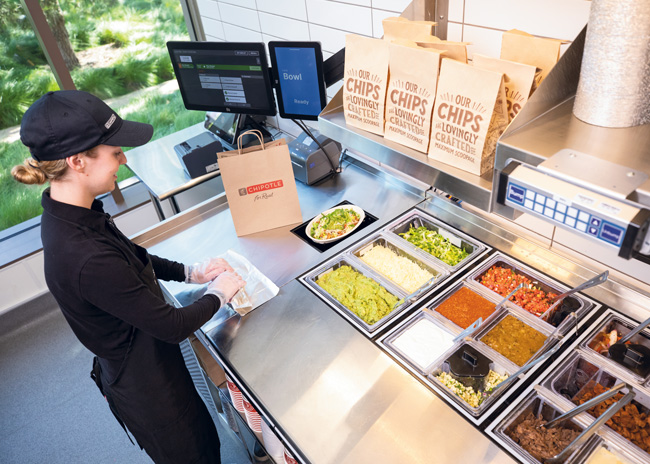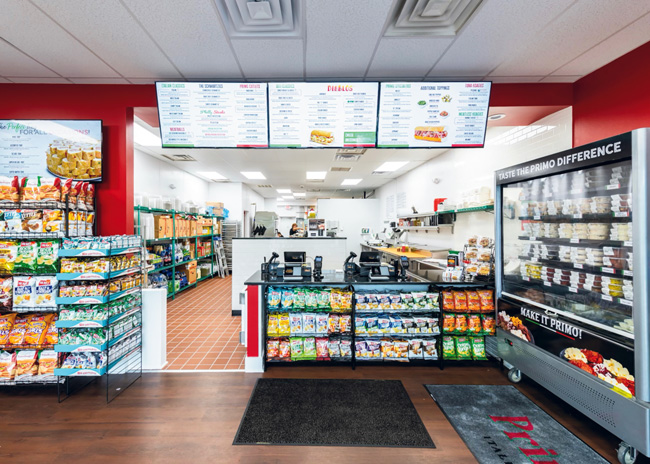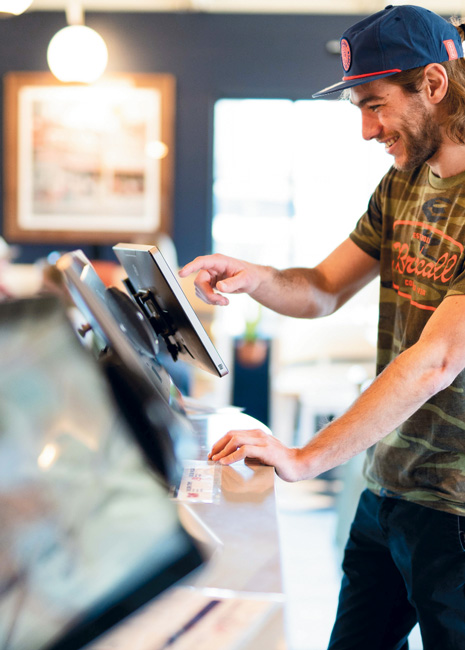One thing we know for sure: Restaurants of the future will continue to solve consumers’ needs and desires for alternatives to cooking and eating at home.
One more thing we know for sure: Restaurants of the future — just like those of the past and present — will continue to evolve, innovate and adapt in order to remain relevant and successful. They’ll set and follow trends, listen to guests, make bold moves and invest in game-changing technologies. And just as they have over the past few years, they’ll continue to reshape the dining experience.
Chatbots, AI-based order systems, virtual brands, self-order kiosks, autonomous delivery, robotics and other solutions that not long ago might have read like sci-fi to operators and guests alike are quickly becoming mainstream plotlines. And new solutions being embraced by leading brands point clearly to the fact that technology will play a prominent role in a brighter, faster, more efficient, customizable and convenient future.
With an eye toward that future, FE&S reached out to industry experts for insights on what they see as some of the biggest changes and opportunities ahead.
 AJ Baird, chief development officer at Full Course, an incubator, accelerator and investor in early-stage food brands
AJ Baird, chief development officer at Full Course, an incubator, accelerator and investor in early-stage food brands
Ed Doyle, president, RealFood Hospitality, Strategy & Design, a foodservice consulting firm owned by Troon, a hospitality and club managment services company
Emily Durham, senior vice president, Food & Beverage Advisory, JLL, a global real estate and investment management company
Ken Schwartz, president and CEO, SSA Foodservice Design & Consulting
When you think about the restaurant of the future, what pops into your mind first?
Schwartz: The single biggest point for operators, but also for designers and consultants, is how to execute with fewer people. For operators, there’s the increasing difficulty of finding and paying for labor, but there are other implications as we look to design and equip restaurants of the future. We will see more operators taking advantage of technology — not necessarily replacing humans with robots but using technology to help produce quality and consistency without having to rely on an employee with a skill set to do it. And we’ll see operators getting smarter about how things like efficient design, ergonomics and ventilation directly impact their ability to create more productive, efficient environments and attract and retain staff. One example I like to share is a study done by the American Society of Heating, Refrigerating and Air-Conditioning Engineers that found that for every 10 degrees F a work environment is out of an employee’s comfort zone, the employee’s productivity immediately drops by 30%. If you think about that statistic, theoretically, for every three people you hire, you need a fourth to overcome the drop in productivity in a kitchen that’s too hot. Another example: What does it mean if we’re laying out kitchens that require employees to take two steps instead of half a step to do something they’re doing repetitively throughout the day? It’s important for restaurants of the future to become more thoughtful and strategic about these types of things.
Doyle: Restaurants are going to continue to face challenges with labor and, simultaneously, to see higher expectations from guests for more flexibility, customization and unique ways to interact with the food and beverage experience. It’s going to get more complicated and resources more constrained. The big challenge is to think about how we can continue to evolve to deliver consistent quality experiences that keep people coming back. For many operators, that means looking for new opportunities to meet customers on their terms, to engage with them, to provide different ways of getting your products to them. That all comes with a host of complications, from delivery to packaging to delivery costs, and we need to continue to work through those, but the demand isn’t going to go away. We need to lean into that and recognize it as the huge revenue-building opportunity that it is.
Durham: There’s not much change in the full-service segments — demand for those same types of spaces and formats remains very strong. The big change is related to off-premises. We don’t anticipate a letup in demand for delivery and takeout any time soon, and that’s having an impact on real estate. Working with restaurants on national or regional rollouts, we’ve typically had a standard prototype to work with, but those are quickly changing because formats are changing. We now see big demand not just for a drive-thru, but for multiple drive-thru lanes, for pickup windows, for designs and spaces that allow for big patios, minimal indoor dining and easy-access mobile order pickup areas. Younger guests in particular are very accepting of technology and automation. Their habits are different, and restaurants of the future will continue to operate in more ways that play to that future customer base.
Baird: For a lot of people, automation is what comes to mind as what future restaurants will look like. But while some of that is necessary given labor shortages, and some is concept appropriate, people generally don’t go to restaurants just for the food. They go for interaction, for ambience and experience. Looking ahead, it’s the blend of technology and hospitality that will be key for most brands. Getting that blend right means really understanding your target customers and how to get to those people as effectively and efficiently as possible via their chosen channels, whether it’s dine-in, pickup, third-party delivery, etc. Operators will need to continue to develop and refine systems that enable them to deliver on all of that while still delivering decent margins to their stakeholders. Planning is no longer about just food and labor and occupancy costs; we now have to figure in third-party fees, technology infrastructure and the cost of bringing in the expertise to make it all work.
What big changes do operators need to consider for the future?
Durham: We’re likely to see a paradigm change in how real estate deals are done. For example, landlords have typically charged on square footage of the building, but buildings are getting smaller, and outdoor spaces, including drive-thrus, are getting larger. Those outside elements have become as valuable as the revenue-producing space inside, if not more so. Some markets have already shifted the equation, but the transition is going to be painful for many operators. Nonetheless, it will have to change because of the fact that interior spaces keep shrinking. Another development of note is the fact that consumers increasingly prefer to interact directly through brands for delivery versus through third parties. That’s a big shift in their operating procedures, so we’ll see how that unfolds.
Baird: McDonald’s announced recently it’s phasing out its self-serve beverage stations. That’s likely in large part because such a larger percentage of orders is now to-go versus dine-in. Chick-fil-A and Panera have introduced new small-unit prototypes with no dining rooms at all. These big format changes are being led by a lot of the really heavy hitters. Another big change is the shift toward more suburban areas and smaller markets, thanks in large part to work-from-home. Brands are learning they can make a difference and do well in small markets; they just have to really understand the dynamics before going in. And the push for reasonably sourced, clean ingredients, plant-based and allergen-free options, sustainability — things that weren’t as relevant 20 years ago — will only become more relevant. Brands need to align with these things and communicate their commitment around them to guests.
Schwartz: One change that needs to happen is how we think about technology. It’s not all about robots. There’s so much technology and automation already out there to help chefs and operators represent their brands and provide quality and consistency. It’s essentially foolproof; no culinary skill set required. The kitchen of the future has to be a combination of clever design and smart, strategic use of such tools. That also includes more energy-efficient equipment. Europe has done a much better job than the U.S. in terms of how they rate and grade the efficiency of electrical equipment, for instance. We need to get on board here as well.
Doyle: The technology of kitchen equipment is certainly a huge change operators need to think about and embrace. The industry has responded well to the labor crisis, and there’s a lot of great smart equipment out there. But part of the challenge is that the industry has a lot of “old dogs” in it. How do we get chefs who have always had a 500-degree combi oven in the middle of the line that runs all day to change how they build menus and food to optimize the equipment? Too often, they’ve bought a Ferrari, but they’re only driving it in first gear. It’s on the operators to know what they’ve got and how to use it, but the equipment companies need to own a lot more of that, too, and think about how they’re providing post-sales support and training. Unless we get people to take full advantage of these tools, we’re only getting halfway to the solution.
Future-Focus: Collaborative Robotics

Chipotle Mexican Grill is testing two new collaborative robotics initiatives, supplementing and supporting human labor with automation. One is a digital makeline, in which bowls and salads are created by an automated system that dispenses ingredients and moves the entrees through a bottom makeline while an employee can simultaneously create burritos, tacos and other items for the same digital order on the unit’s top makeline. Another is a prototype that cuts, cores and peels avocados before they’re hand-mashed by an employee to make guacamole. A Chipotle spokesperson says the brand is, “committed to exploring collaborative robotics to drive efficiencies and ease pain points for our employees. Looking ahead, we see opportunities for more automation in food prep and dishwashing. These are areas that consistently come up in conversations with our crew members. We also see potential in leveraging AI to help our managers be more precise in the amount of food they’re prepping for the restaurants.”
Future-Focus: Team Support, Differentiation
Denver-based Birdcall, a 12-unit fried chicken-focused QSR, launched in 2016 with a goal of using technology to make all-natural foods more affordable and accessible. Leveraging a proprietary, vertically integrated technology system, the chain initially focused on automating the front of house, removing order-taking tasks from associates to focus on hospitality. Mission accomplished, says Peter Newlin, chief experience officer. The brand’s focus has shifted to the kitchen. “We believe the future of restaurants is in the kitchen — not in automation, per se, but in creating more purpose-filled positions that grow team members in the best possible ways,” Newlin notes. “Technology can fuel this development and could transform the industry. We know that over the years, we will utilize more automation, which will be added as it is ready but only if it supports the system and the team in innovative new ways. Anyone can build an efficient restaurant, average food, a beautiful box or an automated line. Very few can create a culture and experience that is memorable. If every restaurant is a robot, what is the differentiator? Brand differentiation is going to become more challenging.”
Future-Focus: Automation Up Front
 In May, Los Angeles-based fast-casual sweetgreen opened its first restaurant powered by automation, a move the company says will accelerate the industry’s adoption of advanced technology as well as its journey toward the future of dining. Located in Naperville, Ill., the pilot store introduced sweetgreen’s Infinite Kitchen, a fully automated, customer-facing system designed to enhance the customer experience as well as food quality, with a focus on fresh ingredients, fast service and friendly hospitality. Jonathan Neman, CEO and co-founder of sweetgreen, noted in the company’s announcement, “We believe that automation will enable us to elevate the quality and integrity of our food while also providing a faster and more convenient experience for our guests and a better, more dynamic job for our team members. With the integration of the sweetgreen Infinite Kitchen in our restaurants, we can unlock efficiencies that will enable us to grow more quickly as we scale.”
In May, Los Angeles-based fast-casual sweetgreen opened its first restaurant powered by automation, a move the company says will accelerate the industry’s adoption of advanced technology as well as its journey toward the future of dining. Located in Naperville, Ill., the pilot store introduced sweetgreen’s Infinite Kitchen, a fully automated, customer-facing system designed to enhance the customer experience as well as food quality, with a focus on fresh ingredients, fast service and friendly hospitality. Jonathan Neman, CEO and co-founder of sweetgreen, noted in the company’s announcement, “We believe that automation will enable us to elevate the quality and integrity of our food while also providing a faster and more convenient experience for our guests and a better, more dynamic job for our team members. With the integration of the sweetgreen Infinite Kitchen in our restaurants, we can unlock efficiencies that will enable us to grow more quickly as we scale.”
Future-Focus: Partnerships, Integration
PrimoHoagies, a 108-unit sandwich chain founded in South Philadelphia, is mining partnerships for integrated technology solutions as it undertakes expansion. Recent moves include shrinking its  store footprint to between 1,500 and 1,800 square feet and streamlining delivery service, partnering with a third-party provider that lets customers order directly through the chain’s website while using the third party’s fleet of drivers. To ensure consistency of its signature fresh-baked bread as it expands, PrimoHoagies partnered with a combi oven manufacturer on programmable smart ovens, which allow staff to easily and consistently finish frozen, par-baked bread on-site throughout the day. The ovens also communicate automatically with designated service agencies should issues arise, decreasing downtime and ensuring one-call fixes. In the front of house, the chain continues to test self-order kiosks and digital display boards that show order progress and streamline the pickup process. And PrimoHoagies’ integrated security system links with its POS system. “We’re able to pull the customer flow through a heat-tracking feature within the security camera system, so when we lay out new stores, we do it in the most efficient way possible,” notes Eric Bronner, chief operating officer. “The system also gives us full visibility into orders, production, packaging and pickup. That’s helped as a training tool but also enables us to reduce costly disputes and charge-backs with third parties. Things are changing very quickly, especially with technology. But we know it’s the key to our future.”
store footprint to between 1,500 and 1,800 square feet and streamlining delivery service, partnering with a third-party provider that lets customers order directly through the chain’s website while using the third party’s fleet of drivers. To ensure consistency of its signature fresh-baked bread as it expands, PrimoHoagies partnered with a combi oven manufacturer on programmable smart ovens, which allow staff to easily and consistently finish frozen, par-baked bread on-site throughout the day. The ovens also communicate automatically with designated service agencies should issues arise, decreasing downtime and ensuring one-call fixes. In the front of house, the chain continues to test self-order kiosks and digital display boards that show order progress and streamline the pickup process. And PrimoHoagies’ integrated security system links with its POS system. “We’re able to pull the customer flow through a heat-tracking feature within the security camera system, so when we lay out new stores, we do it in the most efficient way possible,” notes Eric Bronner, chief operating officer. “The system also gives us full visibility into orders, production, packaging and pickup. That’s helped as a training tool but also enables us to reduce costly disputes and charge-backs with third parties. Things are changing very quickly, especially with technology. But we know it’s the key to our future.”




